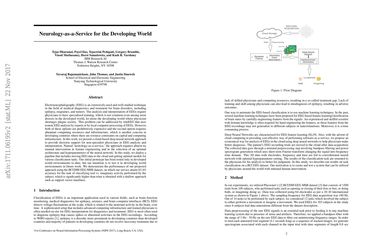Neurology-as-a-Service for the Developing World
Electroencephalography (EEG) is an extensively-used and well-studied technique in the field of medical diagnostics and treatment for brain disorders, including epilepsy, migraines, and tumors. The analysis and interpretation of EEGs require physicians to have specialized training, which is not common even among most doctors in the developed world, let alone the developing world where physician shortages plague society. This problem can be addressed by teleEEG that uses remote EEG analysis by experts or by local computer processing of EEGs. However, both of these options are prohibitively expensive and the second option requires abundant computing resources and infrastructure, which is another concern in developing countries where there are resource constraints on capital and computing infrastructure. In this work, we present a cloud-based deep neural network approach to provide decision support for non-specialist physicians in EEG analysis and interpretation. Named `neurology-as-a-service,' the approach requires almost no manual intervention in feature engineering and in the selection of an optimal architecture and hyperparameters of the neural network. In this study, we deploy a pipeline that includes moving EEG data to the cloud and getting optimal models for various classification tasks. Our initial prototype has been tested only in developed world environments to-date, but our intention is to test it in developing world environments in future work. We demonstrate the performance of our proposed approach using the BCI2000 EEG MMI dataset, on which our service attains 63.4% accuracy for the task of classifying real vs. imaginary activity performed by the subject, which is significantly higher than what is obtained with a shallow approach such as support vector machines.
PDF Abstract

